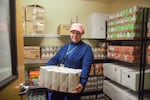It’s the first week of winter break at Portland State University. Final exams are over, and with many students gone for the holidays, the downtown campus is quiet. It also means a crucial service students rely on is closed for the rest of the year.
PSU’s small student-led food pantry is tucked away in the basement of the student union building. It’s long and narrow, like an extra deep one-car garage — with a handful of refrigerators along one wall and shelves of dry goods and cans along another.
The only sound at the pantry this week is the low hum of the refrigerators. But that’s not usually the case.
“By the first three weeks of the fall term, we had an average of 93 students a day,” said Trenna Wilson, a student at PSU and the food pantry’s general manager.
According to Wilson, in the school year prior to the pandemic, the pantry served an average of just over 400 students per week.
Even with fewer students enrolled at PSU, and fewer living on campus, the pantry is busier — with demand ticking up about 3% to an average of 415 students per week this fall term.

Trenna Wilson, a PSU student and general manager of the university's food pantry, stands holding packs of flour in an extra storage closet around the corner from the main small pantry space on Dec. 12, 2022.
Meerah Powell / OPB
The pantry distributes about 5,000 pounds of food per week to students, Wilson said.
Students can make appointments to visit the pantry, but Wilson says many show up as walk-ins and there’s always a line outside before the door opens. With so many students and not a lot of shelf space, Wilson said, it’s not uncommon to run out of some food items.
And as it is now, the pantry just doesn’t have the capacity to serve all of the students who need it.
Wilson, 44, is in her last year at PSU studying history. She started taking classes at the university in 2008 before taking a break. She came back last year.
Wilson started using the food pantry herself when she first started working here last year.
“I was astounded by how much my grocery bills went down as soon as I began to use the pantry and that just very palpable sense of — it doesn’t just make it easier to feed your family or yourself, it helps you pay all of your other bills,” she said.
But, for many students, accessing services like the food pantry can be stressful. Wilson hopes the pantry can continue to address that, especially as the campus attempts to return to normal operations after the past two years of the pandemic.
Combatting trauma in food accessibility
The food pantry has been a crucial resource for students, regardless of the pandemic.
A report out of PSU’s Homeless Research and Action Collaborative surveyed about 3,500 students in late 2019 about their basic needs, including food and housing insecurity.
That report found that nearly 50% of students surveyed experienced food insecurity in the month prior to completing the survey. That’s far higher than the 33% of students reporting food insecurity at four-year institutions across the country, according to data from national surveys PSU examined, such as from the Hope Center.
Accessing basic needs, like food, through services like a pantry, can be traumatizing, said Angela Hamilton, associate director in student activities and leadership programs at PSU. She’s been supervising the pantry since 2015.
“Folks who are food insecure often experience trauma while trying to access services to gain food,” Hamilton said. “The pandemic crisis where food access was so critical when feelings are already heightened, people are already facing a lot of stress, those are especially times when we need to be operating from a trauma-informed lens.”
Hamilton said because the pantry is student-led, she is hands-off in decision making. But she offers information about trauma-informed care to the student-workers.
Food pantry staff take that into account in the ways they serve students, said Wilson.

The PSU Food Pantry has to limit some of the food items students can take due to supply shortages caused by the pandemic. Trenna Wilson, a student and the pantry's general manager, says the pantry hopes to increase its food offerings and move back to an open distribution model.
Meerah Powell / OPB
For example, Wilson said, to avoid potentially stressful surprises, the pantry always makes announcements two weeks in advance if they’re making any major changes. Staff make sure that it’s clear what students will expect on the shelves, in order to make their pantry experiences as smooth as possible. Staff prioritize providing a range of food options.
“It’s as much like a supermarket as we can make it in there,” she said.
Wilson said she and her coworkers have tried to increase the pantry’s food volume as much as they can to avoid having to set limits for students. Such limits were unavoidable earlier in the pandemic with nationwide supply chain shortages.
“A lot of these things are similar to customer service, but instead of from the point of view of, ‘What do we do to encourage people to spend more money?’ It’s, ‘What do we do to make sure that we aren’t adding to that trauma?’” Wilson said.
Wilson says she’s felt that trauma personally when using the pantry. She has a child who has food sensitivities, and she has a few herself too. She said when something comes into the pantry that works for their diets, it can induce anxiety.
“I have that same reaction of when it’s my turn to be a patron, is that still going to be on the shelf? Since our staff all follow the same rules as all the other patrons, we don’t shop when we’re working,” she said. “Knowing that I’m putting that on the shelf at 11 in the morning, and my shopping appointment is at 3, is that really going to be there?”
Shortages caused by the pandemic have intensified anxiety and trauma around food scarcity, but Wilson said the pantry has always operated with a sensitivity toward student needs. However, there are limits to what she and other pantry workers can do with the small space in the student union basement.
Expanding services
Though the pantry is closed for winter break, there are still some free food options on campus and in the area, including a monthly Free Food Market hosted in partnership with the Oregon Food Bank. Wilson worked there earlier this week.
“Since we’re on the park blocks, we’re out in the open air, we have plenty of space, and we just roll the pallets up, and we move the food off the pallet to the place where the patrons pick up the food,” she said of the event. “A couple of people are able to move 4 or 5,000 pounds of food to 200 people in a couple of hours.”
Wilson says that event is proof that there’s more need in the community than the food pantry is currently able to serve in its small space.
PSU’s Basic Needs Hub, which launched in February, is open over the break and is offering some free food out of its office. Along with the opening of that office, PSU hired its first Basic Needs Navigator earlier this year, Lee Phillips, thanks to the passage of a bill in the Oregon Legislature funding those positions to every public university and college in the state.
Phillips says the Basic Needs Hub connects students to resources like affordable student housing, financial aid and food support — referring them to the pantry and the Free Food Market, as well as benefits like SNAP.
Wilson and others at PSU anticipate the demand for food support will continue.
The food pantry primarily gets food through the Oregon Food Bank. It can also purchase food through donations from the PSU Foundation, and it gets excess food from local grocery stores in the area.

The PSU Food Pantry offers canned and dry goods, produce, snacks and other goods like diapers for students with young children.
Meerah Powell / OPB
Wilson said the pantry has access to more food than it can feasibly distribute through the pantry.
“Most of the food that we receive, we receive for free. We are able to obtain more food at no cost,” Wilson said. “I’m really confident we could put twice as much food onto campus if we could just have a large space that we could roll the carts through rapidly.”
The pantry is confined by its current location in the basement of the student union building, Wilson said, and its door is not large enough to roll in food on wooden pallets.
Wilson acknowledged the study that was done before the pandemic, which suggested about half of PSU students experienced food insecurity — far more than use the pantry.
“Presently, we serve usually about 10 or 11% of the student body,” Wilson said. “We could meet all of the need if we were bigger … I know space is scarce, and it’s a hard conversation to have with the university, but I think that this is a priority.”
Wilson is part of an effort to relocate the pantry to a student lounge down the hallway which she says rarely gets used. It has double doors that would better accommodate moving large volumes of food in and out.
PSU confirmed that conversations about moving the pantry to a new space have started, and the university says that request will be discussed formally next month.
In the meantime, Wilson said she and other staff are attempting another way of bringing food to students who need it. They’re setting up mini pantries at different campus resource centers, starting later this school year.
